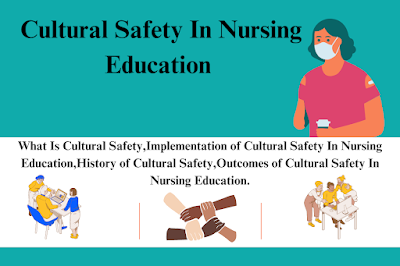Nursing Education and Cultural Safety What is Cultural Safety?
Cultural safety is a concept that refers to the conscious provision of care that ensures patients from diverse backgrounds feel respected and secure in their clinical encounters. It involves an understanding of how power dynamics and historical, sociopolitical contexts influence health care interactions, and aims to protect the identities and dignity of patients, especially those from minority or marginalized groups. Cultural safety emphasizes the importance of creating an environment where the patient feels free from any form of discrimination or marginalization due to their cultural identity.
Implementation of Cultural Safety in Nursing Education
The implementation of cultural safety in nursing education is crucial for preparing nurses to provide respectful, humane, and effective care to all patients. To achieve culturally safe care, nurses and other healthcare providers must understand how power structures in society and within healthcare settings affect health outcomes. This understanding requires deep self-reflection on how personal and professional positions of power influence their interactions with patients (Ramsden, 2002).
Nursing education must aim to identify both conscious and unconscious biases and perceptions toward others and understand how these influence the provision of care. The process involves transforming negative perceptions and attitudes towards culturally diverse groups (Ramsden, 2002). Educational strategies include:
- Knowledge of Historical and Sociopolitical Contexts: Educating students on the historical and sociopolitical contexts that shape power dynamics in health care relationships (Richardson & Carryer, 2005).
- Awareness of Power in Nursing Practice: Highlighting the ways in which power is embedded in nursing practice and affects relationships between nurses and patients (Jeffs, 2001).
- Creating a Safe Learning Environment: Educators must create an environment where all students feel safe to express their cultural identities, engage in self-reflection, and confront their biases (Jeffs, 2001).
Implementing cultural safety education can be challenging, as it often involves addressing sensitive topics related to power, privilege, and discrimination. These discussions can evoke strong emotions such as guilt and blame among students and faculty, especially those from majority groups. To manage these challenges, educators need to foster a learning environment where reflection and open dialogue are encouraged and supported.
History of Cultural Safety
The concept of cultural safety originated in New Zealand in the late 1980s, introduced by Irihapeti Ramsden, a Māori nurse. In 1991, the New Zealand Nursing Council mandated that 20% of the state examination for nurses would focus on cultural safety (Papps & Ramsden, 1996; Ramsden, 2002). Initially focused on ethnic differences, the concept was later expanded to encompass various dimensions of culture, including gender, age, sexual orientation, religion, profession, and disability (Ramsden, 2002).
Cultural safety emphasizes understanding and addressing power imbalances in healthcare relationships rather than simply understanding patients’ cultural customs. It aims to educate nurses to reflect on their own attitudes and behaviors toward patients and understand the impact of their professional authority on patient safety and well-being. This approach contrasts with the concept of cultural competence, which focuses more on the nurse’s ability to provide care that aligns with a patient’s cultural norms and practices (Wells & Black, 2000).
While cultural competence seeks to ensure that nurses are aware of and respectful toward different cultural practices, cultural safety requires a deeper understanding of the dynamics that may threaten a patient’s sense of safety. Some scholars have attempted to merge these two concepts to create a more comprehensive model of care that incorporates both cultural competence and safety (McEldowney & Connor, 2011).
Cultural safety has become a key focus in nursing education in the 21st century, with its applications and implications being explored in various countries, including New Zealand, Australia, Canada, the United States, and Israel (Phiri, Dietsch, & Bonner, 2011; Cash et al., 2013; Doutrich et al., 2012; Arieli et al., 2012).
Outcomes of Cultural Safety in Nursing Education
Integrating cultural safety into nursing education has several important outcomes:
- Promoting Social Justice and Advocacy: Nursing students are educated to see themselves as active social agents who strive to promote social justice. This perspective fosters a sense of responsibility in advocating for equitable health care and challenging discriminatory practices.
- Developing Culturally Safe Practitioners: By incorporating cultural safety principles, nursing education equips future nurses to recognize and mitigate factors that could compromise a patient’s sense of safety and dignity. This preparation is particularly important in diverse societies with histories of colonization, discrimination, and racism.
- Enhancing Critical Reflection and Reflexivity: Cultural safety education encourages both students and educators to engage in ongoing reflection and reflexivity about their cultural identities, biases, and assumptions. This process enhances self-awareness and promotes more equitable care practices.
- Overcoming Resistance and Building Institutional Support: Implementing cultural safety can meet resistance, particularly in environments where discussions of power dynamics and privilege may be uncomfortable. To address these challenges, nursing education programs must secure institutional, national, and international support to sustain these educational efforts.
Conclusion
Cultural safety is a critical concept in nursing education that seeks to create a more inclusive, respectful, and equitable healthcare environment. By understanding the historical, social, and political contexts of patient care, nursing students can become competent practitioners who deliver culturally safe care to all patients. The integration of cultural safety into nursing curricula is essential for fostering social justice and preparing nurses to work effectively in a diverse and ever-changing world. As cultural safety continues to evolve, it is vital for nursing educators to develop programs that address power relations and encourage reflexivity to ensure all patients feel safe and respected in healthcare settings.
